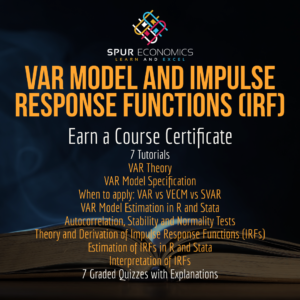The VAR-VECM Goodness of fit can be analyzed using similar methods. After estimating Vector Autoregressive (VAR) or Vector Error Correction Mechanism (VECM), it is essential to assess how well the model fits the data. If the model is a good fit, only then we should move ahead with forecasting and impulse response functions.
Tests of autocorrelation, stability tests and tests of normality of error terms are generally used to assess the fit of the models. Here, we will discuss the tests and also the interpretation of their results. Moreover, these tests may have different interpretations for VAR and VECM. Hence, we will also differentiate between their applications for VAR and VECM models.
Test of Autocorrelation: LM test
The Lagrange-Multiplier test or LM test is used to test for autocorrelation in the VAR and VECM models. The application is similar in both models. In the presence of autocorrelation, the results of the models cannot be considered reliable. We will illustrate the application of this test with the help of the VECM model estimated in VECM Estimation and Interpretation.
In that example, we observed that VECM with 0 lagged differences (1 lag in underlying VAR) suffered from the problem of autocorrelation. To get rid of autocorrelation, we included additional lags in our VECM model and estimated it with 3 lagged differences or 4 lags in underlying VAR. Let us also look at the results for both VECM models with 0 and 3 lagged differences.
H0: no autocorrelation at the given lag order
HA: autocorrelation is significant at the given lag order
| Lag order | VECM with 0 lagged differences | VECM with 3 lagged differences |
| 1 | chi2 = 8.2017; p = 0.08446 | chi2 = 5.2773; p = 0.26001 |
| 2 | 3.0220; 0.55415 | 8.1044, 0.8783 |
| 3 | 9.5124, p =0.04949 | 3.8135; 0.43184 |
| 4 | 6.1178, 0.19052 | 4.1406; 0.38731 |
| 5 | 3.9738, 0.40957 | 2.8139; 0.58943 |
From the results, we can observe that VECM with 0 lagged differences suffers from autocorrelation at lag order 3. The chi-square value is high and the p-value is less than 0.05. Hence, we reject the null hypothesis of no autocorrelation.
To eliminate autocorrelation from the model, we must include more lags in the VECM. Moreover, the results of the LM test show that autocorrelation no longer exists when we include 3 lagged differences in the VECM.
Stability Test of VAR and VECM
The test of stability of VAR and VECM models uses the Eigenvalue stability conditions. The stability condition of VAR and VECM is different, hence, we will further discuss their interpretation separately. Furthermore, a stability test is always carried out after estimating the parameters of the model.
Stability of VAR
The stability condition of VAR states that the modulus of every eigenvalue must be less than 1. All eigenvalues and their moduli can be easily estimated using statistical software packages.
Let us look at the stability statistics for an Unstable VAR model:
| Eigenvalue | Moduli |
| 1.00186 | 1.00186 |
| -0.5874382 | 0.587438 |
| 0.4244816 + 0.2858237i | 0.511742 |
| 0.4244816 + 0.2858237i | 0.511742 |
| -0.3997372 | 0.399737 |
| 0.3383842 | 0.338384 |
The above results show that there is a modulus of an eigenvalue that does not satisfy the stability condition. Since all the moduli are not less than 1, we conclude that the VAR model is unstable. This also means that the variables in the VAR model are not stationary.
The results of such a model are not reliable and cannot be used for forecasting and impulse response functions. The dynamic forecasts for such models can explode and the impulse response functions do not converge. Since the variables are not stationary, we can either use VAR in differences or apply VECM if cointegration exists.
Stability of VECM
The stability condition for VECM is different from VAR models. VECM stability condition states that the model will have “K-r” unit moduli. Here, “K” is the number of endogenous variables in the model and “r” is the number of cointegrating vectors. If a VECM has 2 endogenous variables and 1 cointegrating relationship, it will have exactly 1 unit modulus (K-r = 2 – 1 = 1) or 1 modulus with the value of 1. Suppose, a VECM has 4 endogenous variables and 2 cointegrating relationships, then, it will have exactly 2 unit moduli (k – r = 4 – 2 = 2).
Let us look at the stability results of the VECM with 3 lagged differences we estimated in VECM Estimation and Interpretation. We also applied the LM test to this model above. This VECM has 2 endogenous variables and 1 cointegrating vector. Hence, it should have exactly 1 unit modulus.
| Eigenvalue | Moduli |
| 1 | 1 |
| 0.7083251 | 0.7083051 |
| 0.6587946 | 0.6587946 |
| -0.3925839 + 0.4621215i | 0.606365 |
| -0.3925839 – 0.4621215i | 0.606365 |
| 0.3010765 + 0.4894999i | 0.57468 |
| 0.3010765 – 0.4894999i | 0.57468 |
| 0.4111784 | 0.4111784 |
The results show that there is exactly 1 unit moduli, which satisfies the stability condition for our VECM model. This also means that the specification of the number of cointegrating vectors is correct.
Another important implication of this is that the impulse responses may or may not converge. That is, shocks to variables can be transitory or permanent. To learn more, go to Impulse response functions after VAR and VECM.
Normality of error terms
The error terms of the VAR and VECM models should ideally be normally distributed. If the error terms are not normally distributed, the parameter estimates will not be efficient, however, the results will still be consistent. Skewness, kurtosis and Jarque-Bera test can be applied to test their normality. Using these tests, we test the null hypothesis that the error terms are normally distributed.
Let us look at the results for the VECM model we have been using:
| Equation | Jargue-Bera test | Test of Skewness | Test of Kurtosis |
| D(x) | p = 0.62604 | 0.39962 | 0.63360 |
| D(y) | p = 0.92570 | 0.74403 | 0.82696 |
| All | p = 0.89568 | 0.66495 | 0.87153 |
The results of all the tests show that the error terms are normally distributed because all p-values are greater than 0.05. Hence, we cannot reject the null hypothesis of normality of error terms and we conclude that the errors are not skewed or kurtotic.
Forecasting and Impulse responses
After applying the tests of goodness of fit of VAR and VECM, we can move on to forecasting and impulse responses. If the VAR or VECM model is stable, is not autocorrelated and its error terms are normally distributed, we can obtain impulses responses and dynamic forecasts. In case the tests indicate that the model is not a good fit, we must take care to solve the problems before moving forward.
In the case of autocorrelation, we can simply include more lags till the model shows no autocorrelation. If the VAR model is not stable, the variables are not stationary. We have to either make them stationary to apply VAR in differences or apply VECM if cointegration exists. In the case of unstable VECM, the of number cointegrating vectors must be correctly specified to make the model stable. Finally, Error terms that are not normally distributed still give consistent results and can be tolerated in certain situations where the model is performing well.
Econometrics Tutorials with Certificates
This website contains affiliate links. When you make a purchase through these links, we may earn a commission at no additional cost to you.





Hi! your tutorial was helpful. I have a 0 lagged vecm result (my underlying var is lag 1) and it doesn’t suffer from autocorrelation. how do I interpret the result since it doesn’t show the coefficients for the short run
Please make sure that your model is correctly specified. You already mentioned that there is no autocorrelation. In addition, all your variables must be integrated of the same order and are I(1), the constant and trend are correctly specified in both short run and long run. Ideally, the errors should i.i.d. and normal. If these assumptions/conditions are met, you can interpret the results.
Since you don’t have any lags, it means that the short-run deviations are due to shocks or innovations. So you may be more interested in interpreting the long-run relationship or the cointegrating vector in your results.